To borrow the phrase from Philip Crosby, Quality is Free.
The book, by the same name, was published in 1978, well before the Industrial Digital Age. It laid out the case for a different view of Quality’s mission and how to achieve many of the ideals that Quality Leaders were (and still are) looking for. Among them; Zero Defects.
Economic Conformance
There are two competing views of cost behavior around Quality in business. The first is called the Economic Conformance Model (ECM). The Economic Conformance Model shows that Quality is a “Good Enough” rationalization exercise where the goal is to seek the economic conformance inflection point. The economic conformance inflection point is demonstrated in the figure below, where the costs of achieving improved quality are at the lowest point related to the costs of poor quality.
Economic Conformance is the predominant school of thought (Figure 1). Too bad it is wrong. In the eyes of the customer, quality is never a “good enough” rationalization exercise. The economic conformance model only works when the Cost of Quality metric is incomplete or only considers things that are easy to identify on the P&L statement. Tangible measures of Quality such as:
-
-
-
Warranty
-
Scrap
-
Rework
-
Complaints
Figure 1
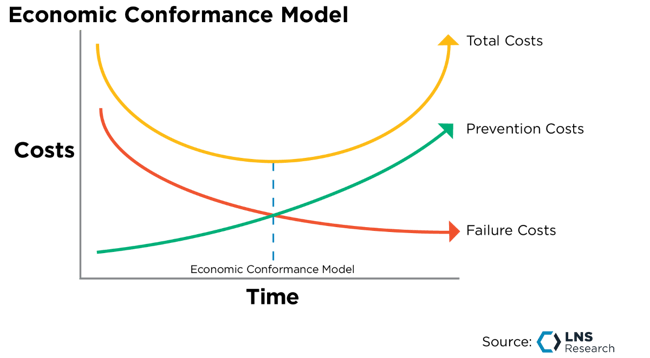
These things are fairly easy to see and measure. If you stop there, then ECM makes sense. The reality is that prevention costs can never outpace failure costs.
Quality is Free
The Quality is Free approach was championed by Philip Crosby in the 1970s. Again, well before the Industrial Digital Age we are currently in now. Quality is Free is the approach which posits that Economic Conformance can never be achieved when all Quality costs are considered. This is a key point. When all costs are considered, the Cost of Quality can reach 20-25% of corporate revenue (Figure 2). The challenge associated with the Quality is Free approach is that most Quality Costs are not actually directly measurable. Things like reputation. Reputation in the marketplace is a real and tangible factor but very difficult to measure and quantify and is nowhere to be found on a P&L Statement. Research by Weber-Shandwick and others has shown there are tangible impacts of a good and a bad reputation in the marketplace. One point of reputation for a $100 million dollar company is worth $630,000 in revenue and between five and nine percent of sales.
Figure 2
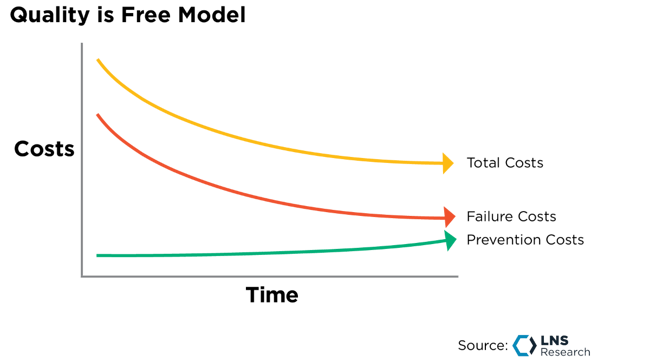
Consider a moderate size business (around $500 million in sales) with moderately acceptable quality (around 4 sigma capability). That business can still see a Cost of Poor Quality in excess of $60 million per year when all factors are in on the Cost of Quality metric. Industrial Transformation (IX) programs rarely see this level of spending for the duration of the initiative, let alone in a single year. Our research shows spending on IX in excess of $5 million per year is a rarity.
Does the Cost of Quality Change in the Digital Age?
The short answer is No, Cost of Quality is still the same, but the Digital Age brings two new factors into play that affect the Cost of Quality calculus.
Customer Sentiment
Since the advent of social media customer sentiment data has been mineable from various sources. The company that ignores this sentiment data does so at its own peril. Our research on Quality 4.0 Maturity shows the Digital Voice of the Customer to be a top use case in the Effort-Impact spectrum, shown below. There’s a lot of bang for the buck from focusing on integrating Voice of the Customer into your digital operations.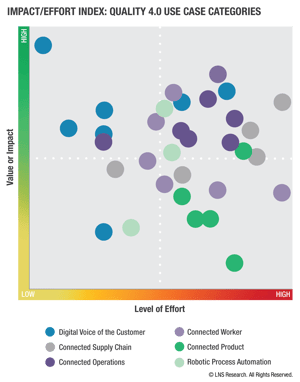
Customer sentiment data can be leveraged into more than just being the hammer for the customer inside the company. Customer sentiment data can be leveraged into insights for:
Prognostic Analytics Changes the Prevention Game
In the age of Industrial Transformation, exciting new technologies are emerging every day and new applications are being envisioned for them. With the advent of very large datasets, meaningful application of Advanced Analytics is possible. These Advanced Analytics follow a progression from Descriptive to Predictive to Prognostic Analytics, see below LNS Research Analytics Framework. For a fuller treatment of the Analytics space, see this post by my colleague Joe Perino.
Prognostic Analytics delivers the ability to predict a likely outcome of a process, and the factors and settings necessary to achieve that desired outcome. Of course, Prognostic Analytics can be combined with customer sentiment data to inform the model of those factors that are important to customer quality, and thus the models can be improved using Voice of the Customer instead of just process and Quality data within the four walls of the operation.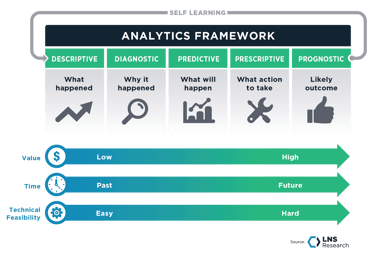
With Prognostic Analytics applied, true prevention can be achieved. Lessons learned through Self Learning Prognostic Modeling can be quickly applied to similar processes to benefit areas where the defect has not yet occurred at a very low cost.
Of course, this change in the paradigm for the Cost of Quality begs the question; How does this affect my technology decisions? The predominance of the Economic Conformances Model has long created challenges for the adoption of technology solutions for Quality reasons. ECM drives a “good enough” mindset, and with limited Quality impact data available under ECM, ROI is hard to achieve, affecting decisions about testing and deploying technology solutions such as Machine Vision or other monitoring technology. This hurdle is much lower in the Quality is Free model, particularly when customer-facing costs such as reputation are factored in, ROI is much easier to achieve.
A read of any of the early Quality Pioneers (Deming, Juran, Crosby, et al.) shows several consistent themes running through their work. One of them is the achievement of Zero Defects, long sought but very difficult to achieve. When we leverage customer sentiment data properly and drive Prognostic Analytics into the Quality practice, we see that Zero Defects are achievable. The Cost of Quality metric can be a key yardstick for measuring the attainment of that desired end-state.
Recommendations for Quality Leaders
-
Develop your Cost of Quality Framework, including hard-to-measure aspects for reputation.
-
Invest in Device and Data Connectivity to make your Cost of Quality closer to “Real-Time.”
-
Invest in Analytics to begin the journey to Prognostic Quality towards the goal of “Zero Defects.”
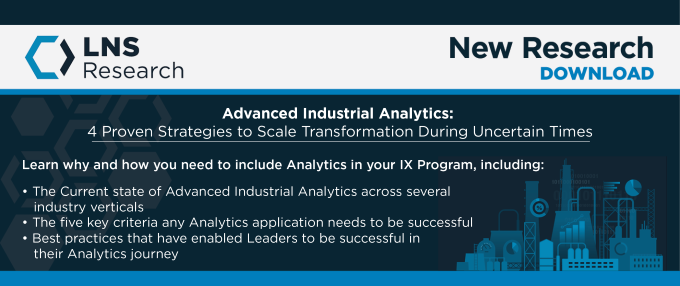
All entries in this Industrial Transformation blog represent the opinions of the authors based on their industry experience and their view of the information collected using the methods described in our Research Integrity. All product and company names are trademarks™ or registered® trademarks of their respective holders. Use of them does not imply any affiliation with or endorsement by them.